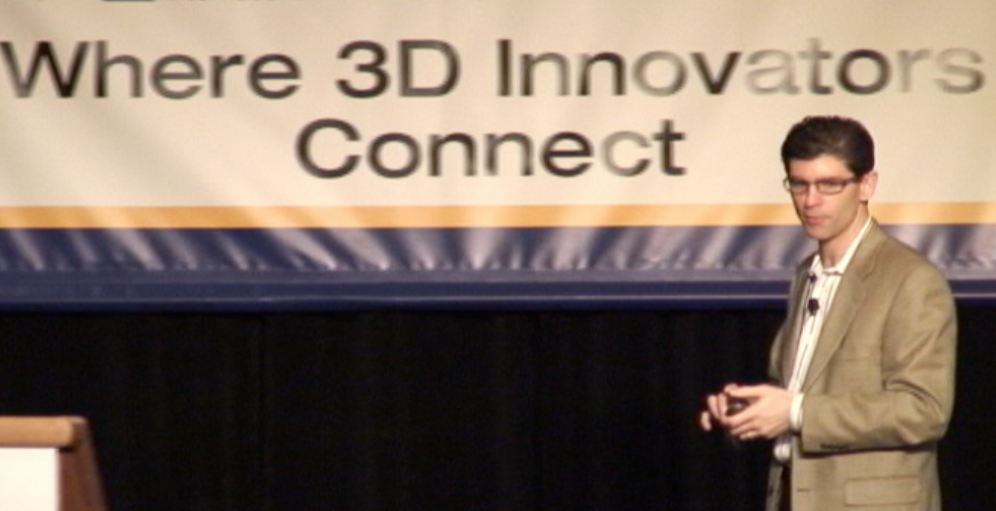Brian Mathews of Autodesk Labs and David Lafferty of BP fire up SPAR International 2011
HOUSTON—If attendees at SPAR International were hoping for an experience that would get them thinking creatively about the ways to use 3D technology in their respective businesses, it would be hard to imagine a better kickoff than the one provided by Brian Mathews, VP of Autodesk Labs, and David Lafferty, part of the Chief Technology Office at BP, during their morning keynote addresses here.
Mathews, especially, wowed the crowd with his predictions for the future of technology and how it would disrupt industry and mainstream society alike. His thoughts on the democratization of reality capture, cloud computing, 3D printing, and how these technologies might converge in the near future had the room buzzing.
Lafferty then followed with how he has practically applied 3D imaging to create a “game changing” experience at BP that has resulted in more than $50 million in efficiency savings – although not without challenges.
See attendee reactions to the presentations in this video below:
Mathews focused largely on technology disruptions, those advances that would significantly change the way people go about their everyday business. For example, he pointed to the quick reduction in cost that FARO has produced with its Focus3D scanner.
“Democratization of scanning is already happening,” he said. “FARO has driven the price point down 60 percent in one year. What will this industry look like in two more years, three more years? Your grandmother and mom will be able to do this. That will increase the demand for reality capture.”
Not only is Autodesk Labs preparing for this by making shape and geometry extraction much easier and more automated in Autodesk products, but the researchers are going further into scanning by gather albedo data and richer information that will allow for even more realistic digital representations of reality. And, on the flip side, photogrammetry advances will allow for a rapid increase in what part of reality is digitized:
“We can now start to have crowdsourcing,” he said, “have consumers taking pictures with their free devices and digitize the entire planet.”
All of this, he said, will be made possible by the cost of computing become virtually free. As Autodesk Labs and others create much lower latency for video, it will become possible to utilize the power of hordes of servers based in the cloud to perform what were previously unthinkable computing operations.
What will this allow? What Mathews called “speculative computing.”
“What if, instead of doing pass-fail to do analysis, I could flip that around, and tell the computer to build the most sustainable building and have it do all the pass-fail automatically? What’s the most optimal solution? I don’t know, but the computer can figure it out really fast with 10,000 computers. And we’re using biomimetics, too, simulating the way biology does evolution. We can take two buildings and let them have sex with each other, and kill off the kids that are the least sustainable and save the best. Because computing is free. This is where we’re going.”
Couple that with the move from digital back to analog in the form of 3D printing and things start to get really exciting.
“What’s the first thing you’d want to print with a 3D printer?” Mathews queried the audience. “A 3D printer!”
Soon, he postulated, 3D printers will go viral, which will completely alter the way that manufacturing is done, making objects similar to MP3 audio files today, completely sharable, so that only the designs have value.
As heads spun thinking about those possibilities, though, BP’s David Lafferty brought the audience back down to Earth with an explanation of how BP is practically using 3D visualization.
One of the most effective applications? Teaching employees in the retail stores at BP how to make donuts and Coney dogs. “We make a lot more money selling donuts than gasoline in retail,” Lafferty noted. “There’s very little profit in gasoline. But our Coney dogs are a hot item.” This method of training, using 3D visualization, has increased retention greatly, putting it at nearly 90 percent for those employees brought into the organization with this kind of training, he said.
Other applications include virtual collaboration, bringing together engineering minds from all over the world in virtual conference environments, and virtual training sessions that allow employees to practice rare operations.
“We’re able to rehearse things that are inherently very dangerous,” Lafferty said. “That reduces our risk profile so much.”
However, the use of 3D visualization came with challenges at BP as well.
“It has interface issues,” Lafferty said. “It has data issues.”
In order for 3D to be accepted organization wide, it needs to be much easier to work with, he said. “How do we make it Google Earth like,” he wondered. Further, interoperability issues need to be solved, it needs to be more clear how one can navigate between 2D and 3D environments, and standards need to be created for service agreements and other interactions with 3D service providers.
In fact, this standardization was one of the most common themes among the two opening keynotes. When SPAR 3D managing director Tom Greaves asked Mathews what the people in the room could do first to start taking advantages of these new technologies coming down the pipeline, Mathews had a very practical answer:
“This group as an industry can set standards,” he said. “When I look at the data types that are coming out of this industry, it’s a lot of different formats. What’s the jpeg for this industry, what’s the MP3? Highly compressed, highly open, and very scalable file formats – that would be the place that I would start.”






